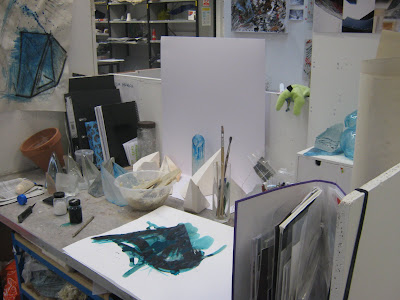Desk at the end of week 2. Still looking a bid naked dispite the new glass editions, could do with some images stuck up of my inspiration. This will be my aim for the end of week 3
Also in the week I made a second investment mould for my arcitectual form, and have booked a kiln for the 11th and over the week end, I'm hoping I'll be able to use the same kiln as last time because I was really happy with the results, may hold the top temperature for an hour or so longer to get rid of those last few bubble, not sure weather to use the copper oxide again although I have been getting a lot of positive feed back off fellow students and staff about the ascetics of the piece. I have worked on making another wax for lost wax casting but as I'm not very happy with how the gelfex turned out last time, I'm planning to make a new gelflex mould and reinforcing it with plaster to make it stronger and so it holds its shape better. I've also made a a copy of the arcitectual shape after the original has been chipped and worn down while I was using it in hot casting and I have put the off cut glass from my kiln cast in a kiln with some copper oxide sprinkled under it, thought it might be a idea to use it to make some related pieces of jewelry.
 Cheered me up a bit :)
Cheered me up a bit :) So far I think the images are strong but compared to some of the portfolios I've seen so far I just think its a little dull, and I haven't got any ideas of how to spruce it up. To be honest I think I would rather have a portfolio of images.
So far I think the images are strong but compared to some of the portfolios I've seen so far I just think its a little dull, and I haven't got any ideas of how to spruce it up. To be honest I think I would rather have a portfolio of images.




































